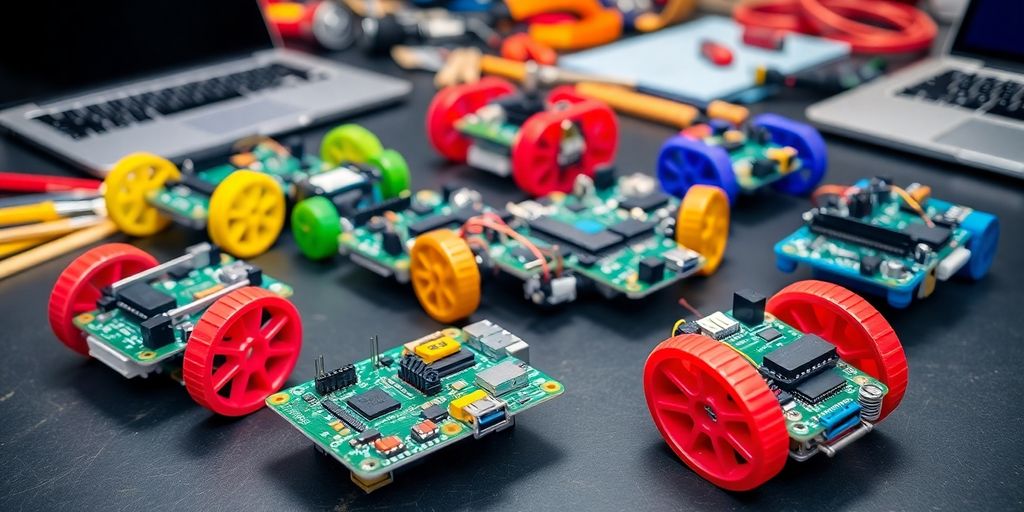Jumping into the world of robotics with a Raspberry Pi can be super exciting, especially if you’re a beginner. These little computers are not just affordable, but they’re also packed with possibilities. Whether you’re looking to build a simple robot or something more complex, Raspberry Pi kits can help you get started. In this guide, we’ll explore some of the best kits available in 2025, perfect for those just starting out with Raspberry Pi robots.
Key Takeaways
- Raspberry Pi robot kits are a great starting point for beginners.
- These kits offer a hands-on way to learn about robotics and programming.
- Many kits come with all the essential components needed to build a robot.
- Beginner kits often include step-by-step guides to make assembly easier.
- User reviews can provide helpful insights when choosing the right kit.
Exploring Raspberry Pi Robot Kits

Understanding Raspberry Pi Basics
Getting into robotics with a Raspberry Pi is exciting! This tiny computer packs a punch and is perfect for robot projects. The Raspberry Pi is like a Swiss Army knife for tech enthusiasts—it can do a lot with very little. It uses GPIO pins to connect with various components, which is crucial for building robots. These pins let you attach sensors, motors, and other gadgets to bring your robot to life. Understanding how these pins work is the first step in your robotics journey.
Choosing the Right Kit
Picking the right robot kit can be tricky. There’s a bunch of options out there, each with its own quirks. Here’s a quick rundown of what to look for:
- Ease of Assembly: Some kits are plug-and-play, while others need a bit more elbow grease.
- Included Components: Make sure the kit has everything you need, like wheels, motors, and maybe even some robotics sensors.
- Programming Support: Does it come with software or guides to help you get started?
Remember, the best kit is one that matches your skill level and project goals.
Essential Components for Robotics
Building a robot isn’t just about the kit. You’ll need a few extra bits and bobs:
- Motors: These are the muscles of your robot. They’ll move your creation around.
- Sensors: From ultrasonic to infrared, sensors are the eyes and ears of your robot.
- Power Supply: A reliable power source keeps your robot running smoothly.
“Starting with a basic kit is smart. As you grow more confident, you can add more complex components to your projects.”
These essentials will help you create a robot that’s not just functional but also fun to build and program. With the right tools and a little patience, your Raspberry Pi robot will be up and running in no time!
Top Raspberry Pi Robot Kits for Beginners
Features of Beginner-Friendly Kits
When you’re just starting out with Raspberry Pi robots, finding a kit that fits your needs is essential. Beginner kits should be easy to assemble, come with clear instructions, and include everything you need to get started. Look for kits that offer:
- Pre-configured components to simplify setup
- A comprehensive guide to help you through the process
- Support for basic programming to get your robot moving
These kits are designed to make your first steps into robotics smooth and enjoyable.
Comparative Analysis of Popular Kits
Here’s a quick comparison of some of the best Raspberry Pi robot kits 2024 for beginners:
| Kit Name | Price Range | Features |
|---|---|---|
| mBot Ranger | $178.74 | 3-in-1 robot, STEM learning |
| mBot Ultimate | $408.74 | 10-in-1 robot, Arduino & Raspberry Pi |
| mBot Basic | $259.99 | Easy setup, great for younger learners |
These kits vary in terms of complexity and price, but they all offer a solid foundation for those new to robotics.
User Reviews and Recommendations
User feedback is invaluable when choosing a Raspberry Pi robot for beginners. Many users praise the mBot Ranger for its affordability and ease of use. The mBot Ultimate, while pricier, is favored for its versatility and ability to integrate with both Arduino and Raspberry Pi. For those looking for an affordable robotics project with Raspberry Pi, the basic mBot is a great pick.
“Starting with robotics was daunting, but these kits made it accessible and fun. The clear instructions and community support were game-changers!”
When picking your first kit, consider what you want to achieve and how much you’re willing to spend. A good kit will not only teach you about robotics but also inspire you to explore further into this exciting field.
Building Your First Raspberry Pi Robot

Step-by-Step Assembly Guide
Embarking on your first DIY Raspberry Pi robot tutorial can be both thrilling and a bit overwhelming. Here’s a basic roadmap to help you get started:
- Gather Your Components: Start with a Raspberry Pi board, a compatible robot chassis, motors, wheels, and a power supply. Make sure all parts are compatible.
- Assemble the Chassis: Follow the instructions specific to your chassis kit. Typically, this involves attaching motors and wheels to the frame.
- Connect the Electronics: Carefully connect the Raspberry Pi to the motor controller. Ensure all wires are securely attached to avoid any mishaps.
- Install Software: Set up the Raspberry Pi OS and install necessary libraries for controlling the motors.
- Test Your Setup: Before finalizing, run a simple script to test motor functionality and ensure everything is working as expected.
Building a Raspberry Pi robot from scratch is a hands-on way to learn about electronics and programming. It’s a rewarding project that combines creativity with technical skills.
Programming Basics for Robotics
Once your hardware is set up, it’s time to dive into programming. Here are some basics to get you started:
- Choose a Programming Language: Python is a popular choice due to its simplicity and robust libraries for robotics.
- Control the Motors: Write scripts to control motor speed and direction. This is where you’ll really start to see your robot come to life.
- Implement Sensors: If your project includes sensors, learn how to read data from them and incorporate it into your robot’s actions.
Troubleshooting Common Issues
Even with the best instructions, things might not always go as planned. Here are some common issues and how to troubleshoot them:
- Power Problems: Ensure your power supply is sufficient for both the Raspberry Pi and the motors.
- Connection Errors: Double-check all connections, especially if the motors aren’t responding.
- Software Bugs: Go through your code to spot any errors or misconfigurations that might be causing issues.
Building a Raspberry Pi robot is a fantastic introduction to DIY robotics. With patience and persistence, you’ll not only have a functional robot but also a deeper understanding of how these systems work.
Enhancing Your Raspberry Pi Robot Skills

Advanced Programming Techniques
Taking your robot programming skills to the next level involves diving into more complex coding. Python robotics is a great place to start, given its simplicity and power. You can experiment with libraries like OpenCV for computer vision or TensorFlow for integrating machine learning robots. These tools can help your robot identify objects or even learn from its environment. Here are a few steps to get started:
- Familiarize yourself with Python libraries specific to robotics.
- Experiment with basic machine learning models.
- Implement obstacle avoidance algorithms using sensor data.
Integrating Sensors and Modules
Adding sensors to your Raspberry Pi robot can make it more autonomous and interactive. Consider integrating modules like ultrasonic sensors for obstacle avoidance or cameras for visual input. Here’s a quick guide to integrating these components:
- Choose sensors based on your project needs.
- Connect sensors to the GPIO pins on your Raspberry Pi.
- Write Python scripts to process sensor data and control robot actions.
Participating in Robotics Communities
Being part of a community can greatly boost your learning and progress. Engaging with others who share your interest in Python robotics can provide support, ideas, and feedback. Consider joining forums, attending workshops, or participating in online challenges. These communities can offer:
- Collaborative project opportunities.
- Access to shared resources and tutorials.
- Platforms to showcase your projects and receive constructive feedback.
Engaging with a community can transform your Raspberry Pi journey, offering insights and inspiration that solo work might not provide. It’s not just about building robots; it’s about building connections and learning together.
By enhancing your skills in these areas, you’ll not only make your robot smarter but also open up new possibilities for creative and functional projects. Whether it’s through Python robotics or integrating new modules, the journey of learning and experimenting with Raspberry Pi is both rewarding and endless.
Educational Benefits of Raspberry Pi Robotics
STEM Learning Opportunities
Raspberry Pi isn’t just a nifty gadget; it’s a gateway to STEM learning. By engaging with Raspberry Pi robotics, students dive into the world of science, technology, engineering, and math. They learn to code, understand electronics, and even get a taste of engineering principles. These skills are not only useful but essential in today’s tech-driven world. Raspberry Pi makes learning these subjects fun and interactive, which can be a game-changer in education.
Hands-On Project Ideas
With Raspberry Pi, the possibilities are endless. Students can build anything from a simple robotic arm to a complex autonomous vehicle. Here are a few project ideas to get started:
- Line-following robot – Teaches basic programming and sensor integration.
- Obstacle-avoiding car – Introduces concepts of distance measurement and motor control.
- Raspberry Pi weather station – Combines coding with data collection and analysis.
These projects not only inspire creativity but also promote critical thinking and problem-solving skills.
Collaborative Learning Experiences
Working on Raspberry Pi projects often involves teamwork. Students can collaborate on building and programming, which enhances their communication and cooperation skills. This kind of learning encourages students to share ideas and solve problems together, preparing them for real-world scenarios where teamwork is key.
Raspberry Pi robotics projects are more than just educational tools; they are platforms for innovation and collaboration. They encourage students to think outside the box and work together to bring their ideas to life.
Future Trends in Raspberry Pi Robotics

Emerging Technologies in Robotics
The world of robotics is evolving rapidly, and Raspberry Pi is right at the forefront. Smart robots are becoming more prevalent, integrating advanced features like computer vision to navigate and interact with their environments more efficiently. These robots are not just about moving around; they are learning to see and understand their surroundings in ways that were once the realm of science fiction.
Predictions for 2025
Looking ahead to 2025, we can expect Raspberry Pi robotics to be even more integrated into daily life. The rise of DIY robotics kits means hobbyists and educators alike can delve into building their own intelligent machines. Line following robots, for instance, are gaining popularity for educational purposes, teaching the basics of automation and sensor integration. This trend is likely to expand, with more sophisticated kits becoming available, allowing for more complex projects.
Innovative Projects to Watch
Innovation is the name of the game. As Raspberry Pi continues to innovate, keep an eye out for projects that push the boundaries of what’s possible. Whether it’s robots that assist in household chores or those that can participate in complex tasks like search and rescue, the possibilities are endless. The integration of new sensors and modules will further enhance the capabilities of these robots, making them more versatile and efficient.
Wrapping It Up
So there you have it, folks! We’ve taken a look at some of the best Raspberry Pi robot kits for beginners in 2025. Whether you’re a complete newbie or just looking to tinker with something new, there’s a kit out there for you. From simple bots that teach the basics to more complex builds that challenge your skills, the options are endless. Remember, the key is to start small and gradually work your way up. Don’t be afraid to make mistakes—it’s all part of the learning process. So grab a kit, get building, and most importantly, have fun! Who knows, you might just discover a new passion or even inspire the next generation of makers. Happy building!
Frequently Asked Questions
What is a Raspberry Pi robot kit?
A Raspberry Pi robot kit is a set that includes a Raspberry Pi computer and other parts to build a robot. It’s great for beginners learning about robotics and programming.
Why should I choose a Raspberry Pi for my robot project?
Raspberry Pi is a small, affordable computer that’s perfect for learning and building robots. It supports many programming languages and can connect to various sensors and motors.
What do I need to start building a Raspberry Pi robot?
To start, you’ll need a Raspberry Pi board, a power supply, an SD card, and a robot kit that includes motors and sensors. Some kits come with everything you need, while others require additional parts.
Can kids build Raspberry Pi robots?
Yes, kids can build Raspberry Pi robots! Many kits are designed to be easy to use, making them perfect for young learners. Building robots can help kids learn coding and engineering skills.
How can I learn to program my Raspberry Pi robot?
You can learn to program your Raspberry Pi robot by following online tutorials, reading books, or joining a robotics club. Start with simple projects and gradually take on more complex tasks.
Are there advanced projects for Raspberry Pi robots?
Yes, once you’re comfortable with the basics, you can take on advanced projects like adding cameras, sensors, or even making your robot autonomous. The possibilities are endless!
Affiliate Disclaimer
This blog contains affiliate links. This means that if you click on a link and make a purchase, I may earn a small commission at no additional cost to you. These commissions help support the work and content I provide on this site.
I only recommend products and services that I genuinely believe will add value to my readers. However, please ensure that you do your own research and make informed decisions before purchasing any products or services mentioned here.
Thank you for your support!



